Statues at Wrest Park
The gardens at Wrest Park contain over thirty statues, sometimes in groups, sometimes placed singly.
Statues on the Main Walk south from the House
There are four statue groups, two each side of the main walk leading down to the fountain. They are painted lead and thought to be about 1730 though their ashlar bases appear to be 19th century.
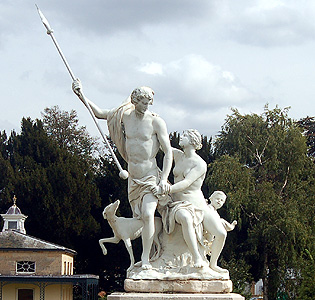
Venus and Adonis in the French Garden September 2011
Closest to the house is a group representing Venus and Adonis. Venus was the Roman version of the Greek Aphrodite, goddess of love. She herself fell in love with the handsome young hunter, Adonis. The group has a seated Venus and a leaving Adonis, complete with spear.
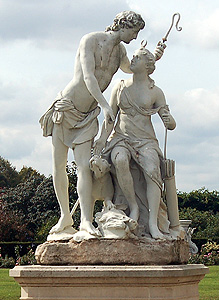
Diana and Endymion in the French Garden September 2011
Opposite Venus and Adonis is a group representing Diana and Endymion. In Greek mythology Endymion was a shepherd who was found sleeping by the moon goddess Selene and she considered him to be so beautiful that she asked his father, the god Zeus, to raise him as an immortal to be her lover. Diana was the Roman version of the Greek Artemis, a virgin goddess! However, in the Renaissance Diana became confused with Selene as goddess of the moon.

Aeneas and Anchises in the French Garden September 2011
Further on, another group represents Aeneas and Anchises. Aeneas was a Trojan who escaped from the sack of Troy by the Greeks carrying his aged father Anchises to safety with him. One version of the foundation of Rome is that it was by Aeneas.
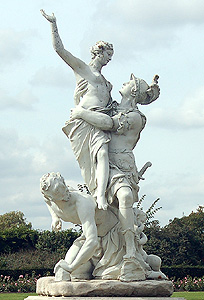
Statue of the Rape of the Sabine in the French Garden September 2011
Opposite this is a group representing the rape of the Sabine women. The legend ran that Rome was founded by Romulus and that he and his friends needed wives. They tried to get them from the neighbouring Sabines, but they refused. Consequently Romulus ordered a feast for the neighbouring peoples and, at a pre-arranged signal, his followers each seized a Sabine woman and carried her off whilst fighting off their male relatives. The group shows a soldier carrying off a distressed woman with another male figure to one side.
Statues around the Fountain
Eight statues stand around the fountain. All are in grey marble on stone plinths and were probably made about 1840 for Thomas Philip, 2nd Earl de Grey who built the new mansion at Wrest and knocked the old house, which stood in this area down, the last parts going in 1840.
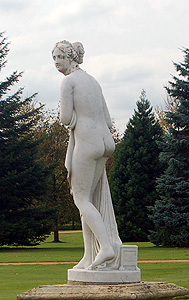
Statue of Venus seen from behind September 2011
North-north-east stands a partially draped female displaying a generous portion of her anatomy. This leads experts to assume she is Venus, the Roman form of the Greek Aphrodite, goddess of love and seduction.
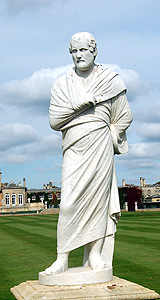
Statue of Cato near the Fountain September 2011
East-north-east stands a bearded male figure in classical dress. He is thought to represent Cato. Marcus Porcius Cato Uticensis (95 BC – 46BC) was a Roman politician renowned for his Spartan lifestyle and moral integrity, He committed suicide rather than be forgiven by his great enemy Julius Caesar
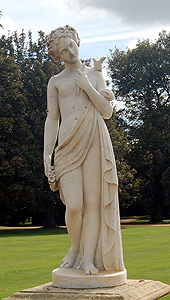
Statue of Iris near the Fountain September 2011
East-south-east stands a female figure with a wreath of lilies in her hair and a small bird on her left shoulder. She holds a wreath of lilies in her right hand. She is thought to represent Iris, a messenger of the Greek gods and personification of the rainbow.
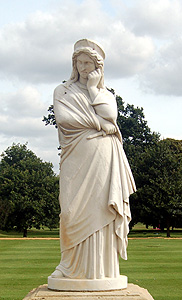
Statue of the Tragic Muse near the Fountain September 2011
South-south-east stands a female figure in classical dress and with a brooding expression, she holds a dagger in her right hand and represents Tragedy
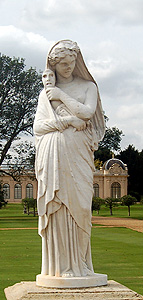
Statue of the Comic Muse near the Fountain September 2011
South-south-west stands a female figure in classical dress. She has flowers in her hair and holds a mask in her left hand. She represents Comedy, the mask being a smiling figure; classical drama was performed in masks.
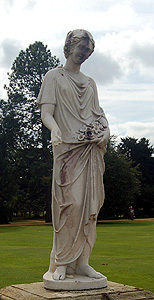
Statue of Flora near the Fountain September 2011
West-south-west stands a female figure in classical dress holding flowers in the folds of her dress. She is thought to represent Flora, Roman goddess of flowers and the Spring.

Statue of Pandora near the fountain September 2011
West-north-west stands a female figure clasping draperies to her. A small box stands at her heels. She may represent Pandora. In Greek mythology Pandora opened a box she had been told to leave closed and this released all the troubles into the world. She slammed the lid quickly trapping one inside but released it, too, when she realised that this was hope.

Statue of Ceres near the Fountain September 2011
North-north west stands a female figure in classical dress. She holds a small sheaf of corn in her left hand and thus represents Ceres, Roman goddess of agriculture.
Statues around the Sundial
Six statues stand around the sundial. All are in marble on stone plinths and were probably made about 1840 for Thomas Philip, 2nd Earl de Grey who built the new mansion at Wrest and knocked the old house, which stood in this area down, the last parts going in 1840.
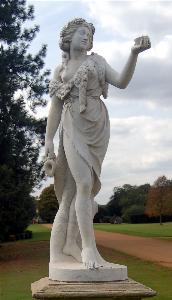
Bacchante statue on the west of the group round the sundial September 2011
To the west stands a female figure in an animal skin and a vine wreath in her hair. She carries a dish in one hand and ewer in the other. She is a bacchante, a follower of the Roman god Bacchus (the Greek god was called Dionysus), god of wine and frenzy.
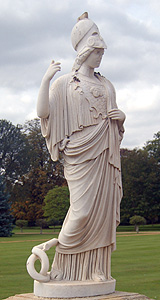
Statue of Minerva September 2011
To the north-west stands a female figure in classical dress wearing a helmet and breast plate bearing the head of the Medusa. Her right arm is raised and it is probable that she originally held a spear. A serpent lies at her heels. She represents Minerva, the Roman version of the Greek Athene, goddess of wisdom.
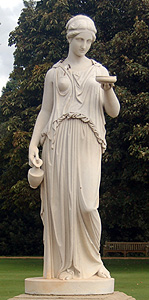
Statue of Hebe September 2011
To the north-east stands a female figure in classical dress holding a dish in one hand and a ewer in the other. She is thought to represent Hebe, the Greek goddess of eternal youth.
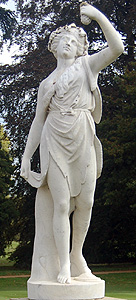
Bacchante statue on the east of the group round the sundial September 2011
To the east stands another bacchante. She is dressed in an animal skin and has a vine wreath in her hair. She is holding up a bunch of grapes.

Bacchante statue on the south-east of the group round the sundial September 2011
To the south-east stands another bacchante. She is dancing, wearing an animal skin and with a vine wreath in her hair. She is playing a tambourine.
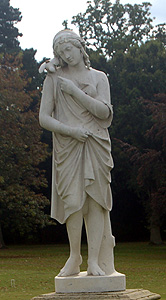
Statue of a girl on south-west of a group round the sundial September 2011
To the south-west stands a girl in classical draperies. She has a dove on her right shoulder.
Statues along the Long Canal
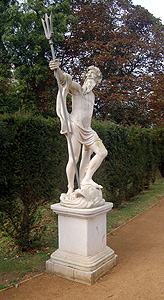
Statue of Neptune September 2011
On the west side of the canal is a statue representing Neptune, Roman version of the Greek god of the sea, Poseidon. The statue is stone and stands on a stone plinth; it is mid 19th century. The figure is partially draped and rather slender. A dolphin's head lies at his left foot and a dolphin's tail is in his left hand. The right hand is outstretched and originally held a trident.

Statue of Juno September 2011
On the north-west side is a mid 19th century statue in marble of a matronly woman holding a baton and a laurel wreath. She probably represents Juno, the Roman version of Hera, Queen of the Gods.

Statue of Leda and her swan September 2011
On the north-east side of the Long Canal is a statue probably dating to about 1840 in marble. It depicts a young woman holding a swan and so is probably Leda. In Greek mythology Leda was seduced by the god Zeus in the form of a swan. She gave birth to Helen of troy, the most beautiful woman in the world whose abduction by the Trojan prince Paris started the Trojan War.

Statue of Mercury September 2011
On the east side of the Long Canal is a mid 19th century stone statue of Mercury. Mercury was the Roman equivalent of Hermes the Greek messenger of the gods, also patron of merchants, thieves and sport. He has a winged hat and winged sandals. His right arm is outstretched and holding drapery.
Other Statues
At the west end of Ladies Lake is a mid 19th century statue of an old man with a flowing beard wearing a hat and a long coat.
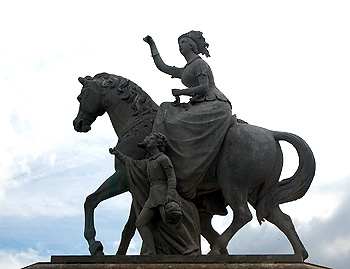
Closeup of the Hawking Party statue September 2011
A hundred and forty yards south of the Orangery is a very striking statue group. It belongs to the mid 19th century and has a woman on horseback holding out her arm for a hawk. Men and boys run alongside. It is known as the Hunting Party. It is made of ashlar and stands on a rectangular plinth, on a raised mount encircled by trees.
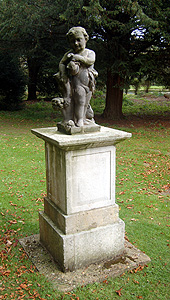
Statue of an infant holding fruit September 2011
A hundred yards south-east of the Bowling Green House is the statue of an infant. It is in stone and stands on a stone plinth. It is probably mid 19th century. The infant is partially draped and hold fruit with a rabbit seated at the left heel.
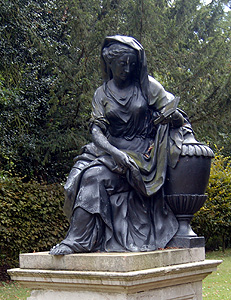
Statue of Jemima, Duchess of Kent September 2011
Twenty five yards south of the West Half House is a statue of a woman in lead, on a stone plinth. She is seated in classical dress, resting on an urn and with an open book in her left hand. She is thought to represent Jemima, first wife of the Duke of Kent; she died in 1728.
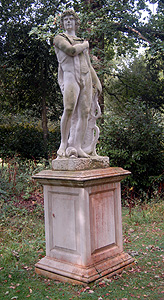
Statue of Apollo September 2011
Forty five yards south-east of the West Half House is a marble figure on a stone plinth. It probably dates to around 1840 and represents a young man dressed in an animal skin, holding a bow in his left hand, with a dead serpent at his feet. The statue is thought to represent Apollo, classical god of the Sun and the arts.
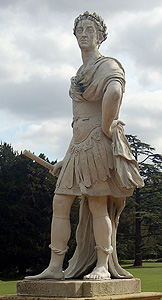
Statue of William III September 2011
Forty yards or so in front of the Banqueting House is a statue of King William III (1689-1702) in Roman armour by the Flemish sculptor John Nost or his son, also John. It dates to the period 1727 to 1730. The inscription reads: "King William the 3rd of Glorious and Immortal memory".
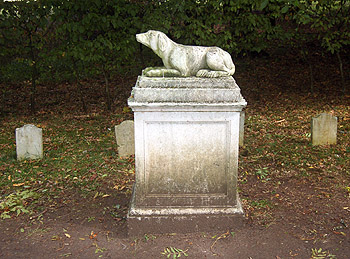
Statue of a dog in the Dogs' Cemetery September 2011
In the Dogs' Cemetery on the east side of the Long Lake is a mid 19th statue of, appropriately enough, a dog. It is lying down and carved out of ashlar.
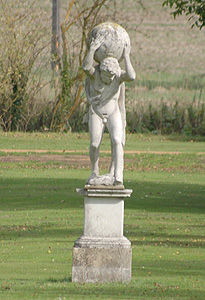
Statue of Atlas September 2011
Two hundred and fifty yards south-east of the house stands a statue in a pond, currently [2011] dry. It is carved ashlar and represents Atlas, the Titan of Greek mythology who holds the world on his shoulders. It is called the Atlas Fountain but is not a fountain, just a statue!

The Italian Garden September 2011
On the north side of the West Parterre, in the Italian Garden, is a mid 19th century statue in marble on a stone plinth. It represents a woman with a large cornucopia of fruit and flowers.